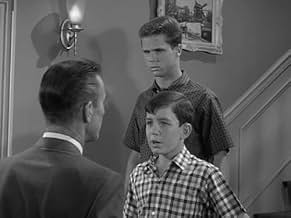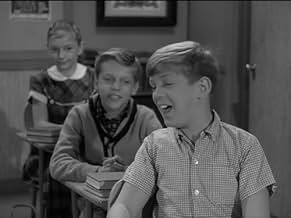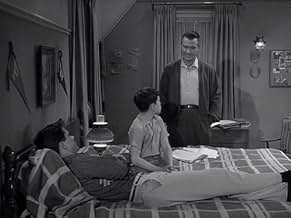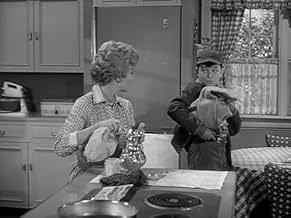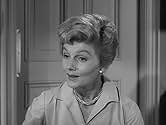Segue le disavventure di un ragazzo di periferia, della famiglia e degli amici.Segue le disavventure di un ragazzo di periferia, della famiglia e degli amici.Segue le disavventure di un ragazzo di periferia, della famiglia e degli amici.
- Candidato a 2 Primetime Emmy
- 5 vittorie e 4 candidature totali
Sfoglia gli episodi
Trama
Lo sapevi?
- QuizAlthough the series was still earning good ratings, its star, Jerry Mathers, wanted to retire from acting to focus on his education upon entering high school. As a result, it was agreed to halt production and the series became the first prime time American production to have a series finale.
- BlooperDuring season one, Wally was in 8th grade and Beaver was in 2nd - six years apart. By the end season six Beaver was finishing 8th grade and Wally was graduating high school - 4 years apart.
- Citazioni
June Cleaver: Wally, where are you going?
Wally Cleaver: I'm going over to slug Eddie.
June Cleaver: That's no way to talk, this is Sunday.
Wally Cleaver: You're right, I'll wait 'til tomorrow and slug him in the cafeteria.
- Curiosità sui creditiThe actor who plays "Beaver" is always credited at the beginning of the show as "And Jerry Mathers...as The Beaver".
- ConnessioniFeatured in Prime Times (1983)
Recensione in evidenza
"Leave It to Beaver" (1957-1963) is a family show set in the suburban town of Mayfield that focuses on the Cleaver family: Ward (Hugh Beaumont), father and accountant; June (Barbara Billingsley), wife and stay-at-home Mom; and their two boys, Wally (Tony Dow) a teenager, and their youngest, Theodore, better known to everyone as "Beaver" (Jerry Mathers). While television of the 1950s and '60s had its share of family shows during its black and white age, including "Father Knows Best" with Robert Young and Jane Wyatt; "The Donna Reed Show" (with Donna Reed and Carl Betz); "Dennis the Menace" (starring Jay North); and later, the long running series, "My Three Sons" (1960-1972) with Fred MacMurray, it seemed unlikely that "Leave It to Beaver" would become the one sit-com to survive and continue to air on television, whether locally or on cable, decades after its concluding episode in 1963. The aforementioned family comedy shows had its share of reruns before slowly disappearing to Limbo, replaced by newer programs to its Color- oriented viewers, but this innocent black and white show which was done on film and not on video tape and to date never colorized to attract younger viewers, still entertains as is. "Leave It to Beaver" geared to its younger viewers when first aired, but today, the children who loved it back then are either adults or grandparents currently sharing their TV memories with their young ones. And the tradition continues.
Like most long-running shows, this one lasting six seasons, the earlier episodes are the best, mixing comedy, charm and well scripted dialog. It's obvious that the writer or writers who developed this program had fond memories of what it's like being a child, for that many of the show's characters, mainly children, could easily be identified by someone we at one time had know in our youth, one character in particular being Judy Henson, the school's pony tailed tattle-tale, teacher's pet and know-it-all. Beaver's closest friend during the first couple of seasons was the chubby Larry Mondello, while Wally's pals were Chester, Tooey and the conniving Eddie Haskell. Over the years, characters have come and gone, but the writers managed to find new friends for Beaver while they kept and expanded the Eddie Haskell character, played to perfection by Ken Osmond, one of the most memorable and "smooth" characters created and developed. Along the way, Chester and Tooey were just phased out, and a new character, Clarence "Lumpy" Rutherford (Frank Bank) stepped in. At first, Lumpy was the neighborhood bully who hounded Wally and the Beav, to eventually became one of Wally's closest friends.
With each passing season viewers got to see the show's new opening, watching the boys growing and maturing to young adults by season six. During the final season, the instrumental theme song remained the same, though jazzed for its final season (1962- 63). By then, Beaver, the central titled character has turned 14, losing his innocent and boyish charm and becoming least interesting character. With the writers sensing this, the scripts placed Beaver in support in several episodes while stories revolved around more on Wally and his friends. There were even segments in which either Lumpy or Eddie would have almost an entire episode, but when Beaver became the central character, it lacked something, becoming mediocre episodes. By mid season, Beaver would start becoming more interested in girls. After 235 episodes, the Cleaver family went into retirement.
The amazing aspect about this program is the development of its characters, not only the central ones but the supporting crew. Aside from Ken Osmond's ever so polite Eddie, who's well mannered in front of the adults and a "big mouth, wise guy" to his pals, there's Richard Deacon as Fred Rutherford, Lumpy's father; the charming Sue Randall as Miss Landers, Beaver's teacher; Burt Mustin as Gus, the fireman; Beaver's other friends including Stanley Fafara as Whitey Whitney, who appeared occasionally through the show's six seasons; Stephen Talbot as Gilbert, and Richard Correll as Richard Rickover. The show might have its share of contradiction, there was a Violet Rutherford, Fred's daughter/ Lumpy's sister, who disappeared, leaving Lumpy the Rutherfordf's only "offspring," while Gilbert Bates introduced as the only child of his widowed father, to suddenly have a mother and sister in later episodes who never appear.
Aside this being a comedy show, "Leave It to Beaver" does take time out for some tender moments. In almost every episode, after either Wally or the Beav, or both, get tangled up with problems, whether it be their fault or not, there is usually a good father to son(s) lecture, along with the moral lesson to what's occurred. One in particular line recited by Ward (Hugh Beaumont) to his wife, June, that stands out is, "The way to get your children's love is to first earn their respect." Occasionally mother June would have her moment of truth with her boys as well, giving them the lesson, value and facts of life, something currently missing in today's TV family sitcoms. And even when the parents are in the wrong, this is one of those rare cases in which the TV Dad or Mom will come out and admit it, showing its viewers that even the parents aren't perfect, but they do what's best for their children as well as learning from their own mistakes.
There are many classic episodes, the one hailed the best where Beaver gets trapped in a billboard soup bowl. Regardless of its age, "Leave It to Beaver" is harmless fun, good family viewing. There was even a 1983 reunion show, "Still the Beaver," along with a new up-to-date series, "The New Leave It to Beaver" (1985-1989). While it's good seeing those familiar faces again, a little older and slightly wiser, but minus the deceased Hugh Beaumont, who is sorely missed, nothing comes close to this original series.
Like most long-running shows, this one lasting six seasons, the earlier episodes are the best, mixing comedy, charm and well scripted dialog. It's obvious that the writer or writers who developed this program had fond memories of what it's like being a child, for that many of the show's characters, mainly children, could easily be identified by someone we at one time had know in our youth, one character in particular being Judy Henson, the school's pony tailed tattle-tale, teacher's pet and know-it-all. Beaver's closest friend during the first couple of seasons was the chubby Larry Mondello, while Wally's pals were Chester, Tooey and the conniving Eddie Haskell. Over the years, characters have come and gone, but the writers managed to find new friends for Beaver while they kept and expanded the Eddie Haskell character, played to perfection by Ken Osmond, one of the most memorable and "smooth" characters created and developed. Along the way, Chester and Tooey were just phased out, and a new character, Clarence "Lumpy" Rutherford (Frank Bank) stepped in. At first, Lumpy was the neighborhood bully who hounded Wally and the Beav, to eventually became one of Wally's closest friends.
With each passing season viewers got to see the show's new opening, watching the boys growing and maturing to young adults by season six. During the final season, the instrumental theme song remained the same, though jazzed for its final season (1962- 63). By then, Beaver, the central titled character has turned 14, losing his innocent and boyish charm and becoming least interesting character. With the writers sensing this, the scripts placed Beaver in support in several episodes while stories revolved around more on Wally and his friends. There were even segments in which either Lumpy or Eddie would have almost an entire episode, but when Beaver became the central character, it lacked something, becoming mediocre episodes. By mid season, Beaver would start becoming more interested in girls. After 235 episodes, the Cleaver family went into retirement.
The amazing aspect about this program is the development of its characters, not only the central ones but the supporting crew. Aside from Ken Osmond's ever so polite Eddie, who's well mannered in front of the adults and a "big mouth, wise guy" to his pals, there's Richard Deacon as Fred Rutherford, Lumpy's father; the charming Sue Randall as Miss Landers, Beaver's teacher; Burt Mustin as Gus, the fireman; Beaver's other friends including Stanley Fafara as Whitey Whitney, who appeared occasionally through the show's six seasons; Stephen Talbot as Gilbert, and Richard Correll as Richard Rickover. The show might have its share of contradiction, there was a Violet Rutherford, Fred's daughter/ Lumpy's sister, who disappeared, leaving Lumpy the Rutherfordf's only "offspring," while Gilbert Bates introduced as the only child of his widowed father, to suddenly have a mother and sister in later episodes who never appear.
Aside this being a comedy show, "Leave It to Beaver" does take time out for some tender moments. In almost every episode, after either Wally or the Beav, or both, get tangled up with problems, whether it be their fault or not, there is usually a good father to son(s) lecture, along with the moral lesson to what's occurred. One in particular line recited by Ward (Hugh Beaumont) to his wife, June, that stands out is, "The way to get your children's love is to first earn their respect." Occasionally mother June would have her moment of truth with her boys as well, giving them the lesson, value and facts of life, something currently missing in today's TV family sitcoms. And even when the parents are in the wrong, this is one of those rare cases in which the TV Dad or Mom will come out and admit it, showing its viewers that even the parents aren't perfect, but they do what's best for their children as well as learning from their own mistakes.
There are many classic episodes, the one hailed the best where Beaver gets trapped in a billboard soup bowl. Regardless of its age, "Leave It to Beaver" is harmless fun, good family viewing. There was even a 1983 reunion show, "Still the Beaver," along with a new up-to-date series, "The New Leave It to Beaver" (1985-1989). While it's good seeing those familiar faces again, a little older and slightly wiser, but minus the deceased Hugh Beaumont, who is sorely missed, nothing comes close to this original series.
I più visti
Accedi per valutare e creare un elenco di titoli salvati per ottenere consigli personalizzati
Dettagli
- Data di uscita
- Paese di origine
- Sito ufficiale
- Lingua
- Celebre anche come
- Leave It to Beaver
- Luoghi delle riprese
- Aziende produttrici
- Vedi altri crediti dell’azienda su IMDbPro
- Tempo di esecuzione30 minuti
- Colore
- Mix di suoni
- Proporzioni
- 4:3
Contribuisci a questa pagina
Suggerisci una modifica o aggiungi i contenuti mancanti





